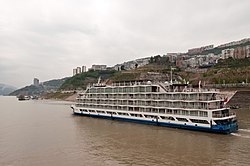world.wikisort.org - China
Rugao (Chinese: 如皋; pinyin: Rúgāo) is a county-level city under the administration of Nantong, Jiangsu province, China, located in the Yangtze River Delta on the northern (left) bank of the river.
Rugao
如皋市 | |
|---|---|
County-level city | |
 | |
 Rugao Location in Jiangsu | |
| Coordinates: 32°14′46″N 120°35′28″E[1] | |
| Country | People's Republic of China |
| Province | Jiangsu |
| Prefecture-level city | Nantong |
| Area | |
| • Total | 1,576.47 km2 (608.68 sq mi) |
| Population (2018) | |
| • Total | 1,241,700 |
| • Density | 790/km2 (2,000/sq mi) |
| Time zone | UTC+8 (China Standard) |
| Postal Code | 226500 |
History

In 411, the western part of then Hailing (Taizhou) was separated from the county to create Rugao county, which named after a coastal village. During Sui dynasty, the county was merged into Ninghai county. Restored in 952, the county was transferred to then Tongzhou in 1724.[2] Around the 1930s, Rugao was the most populous county in then Jiangsu province.[3] Two county governments of the New Fourth Army were established in the then county: Ruxi (literally Western Rugao) and Rugao (1940–5, was renamed as Rudong by the CPC in November 1945 ), while the Tongzhou-Yangzhou Canal marked the boundary between the two regions, during the Second Sino-Japanese War. Ruxi succeed to the designation Rugao in 1945, the reshuffling of territory came true only in January 1949, when the CPC totally controlled the area. On 1 June 1990, with approval of the State Council, Rugao was turned into a county-level city, which went into effect in 1991.[2]
Administrative divisions
In the present, Rugao City has one subdistrict and 19 towns.[4]
- 1 subdistrict
- Rucheng (如城镇)
- 19 towns
|
|
Climate
| Climate data for Rugao (1981−2010) | |||||||||||||
|---|---|---|---|---|---|---|---|---|---|---|---|---|---|
| Month | Jan | Feb | Mar | Apr | May | Jun | Jul | Aug | Sep | Oct | Nov | Dec | Year |
| Record high °C (°F) | 19.0 (66.2) |
25.6 (78.1) |
27.7 (81.9) |
32.4 (90.3) |
34.7 (94.5) |
37.0 (98.6) |
37.4 (99.3) |
38.0 (100.4) |
36.8 (98.2) |
32.0 (89.6) |
27.9 (82.2) |
22.5 (72.5) |
38.0 (100.4) |
| Average high °C (°F) | 6.8 (44.2) |
8.7 (47.7) |
13.1 (55.6) |
19.1 (66.4) |
25.0 (77.0) |
28.1 (82.6) |
31.2 (88.2) |
30.8 (87.4) |
27.0 (80.6) |
22.3 (72.1) |
16.1 (61.0) |
9.6 (49.3) |
19.8 (67.7) |
| Daily mean °C (°F) | 2.4 (36.3) |
4.2 (39.6) |
8.1 (46.6) |
13.8 (56.8) |
19.3 (66.7) |
23.5 (74.3) |
27.2 (81.0) |
26.7 (80.1) |
22.7 (72.9) |
17.1 (62.8) |
10.9 (51.6) |
4.7 (40.5) |
15.1 (59.1) |
| Average low °C (°F) | −0.8 (30.6) |
0.8 (33.4) |
4.1 (39.4) |
9.0 (48.2) |
14.5 (58.1) |
19.6 (67.3) |
24.0 (75.2) |
23.6 (74.5) |
19.2 (66.6) |
12.9 (55.2) |
6.6 (43.9) |
0.9 (33.6) |
11.2 (52.2) |
| Record low °C (°F) | −10.4 (13.3) |
−8.4 (16.9) |
−5.0 (23.0) |
−2.2 (28.0) |
4.8 (40.6) |
10.0 (50.0) |
16.5 (61.7) |
16.1 (61.0) |
9.3 (48.7) |
−0.3 (31.5) |
−3.8 (25.2) |
−13.4 (7.9) |
−13.4 (7.9) |
| Average precipitation mm (inches) | 48.2 (1.90) |
46.0 (1.81) |
75.9 (2.99) |
66.9 (2.63) |
91.3 (3.59) |
151.6 (5.97) |
184.0 (7.24) |
144.0 (5.67) |
95.3 (3.75) |
55.1 (2.17) |
58.6 (2.31) |
30.7 (1.21) |
1,047.6 (41.24) |
| Average relative humidity (%) | 76 | 76 | 77 | 78 | 78 | 81 | 85 | 85 | 83 | 79 | 77 | 74 | 79 |
| Source: China Meteorological Data Service Center[5] | |||||||||||||
Education
- Baipu Middle school (1950)
Tourism
- Shuihui Garden
- Lingwei Taoist Temple
- Red Army Memorial Museum
Notable people
- Henry Lee, criminologist
- Zhu Qianhua, writer
- Huang Beijia, writer
- Xiaowei Zhuang, biophysicist
- Zhu Meifang, materials scientist
References
- Google (2014-07-02). "Rugao" (Map). Google Maps. Google. Retrieved 2014-07-02.
- 中国历史地名大辞典 [The Great Encyclopaedia of Chinese Historical Toponyms]. p. 1154. ISBN 978-7-500-44929-4.
- 江苏省志・人口志 [Jiangsu Provical Gazetteer, Volume on Demography]. Fangzhi Publishing House. pp. 90–8. ISBN 978-7-801-22526-9.
- "南通市-行政区划网 www.xzqh.org" (in Chinese). XZQH. Retrieved 2012-05-24.
- 中国地面气候标准值月值(1981-2010) (in Simplified Chinese). China Meteorological Data Service Center. Retrieved 7 November 2022.
External links
- (in Chinese) Rugao government
- (in Chinese) Rugao City English guide (Jiangsu.NET)
- (in English and Chinese) "Illustrated Album of Yangzhou Prefecture", from 1573 to 1620, has illustrations of Rugao
На других языках
- [en] Rugao
[fr] Rugao
Rugao (en chinois : 如皋 ; pinyin : Rúgāo) est une ville de la province du Jiangsu en Chine. C'est une ville-district placée sous la juridiction de la ville-préfecture de Nantong.[it] Rugao
Rugao (如皋市S, RúgāoP) è una città-contea della Cina, situata nella provincia di Jiangsu e amministrata dalla prefettura di Nantong.[ru] Жугао
Жуга́о (кит. упр. 如皋, пиньинь Rúgāo, буквально: «земля у уреза воды») — городской уезд городского округа Наньтун провинции Цзянсу (КНР).Другой контент может иметь иную лицензию. Перед использованием материалов сайта WikiSort.org внимательно изучите правила лицензирования конкретных элементов наполнения сайта.
WikiSort.org - проект по пересортировке и дополнению контента Википедии